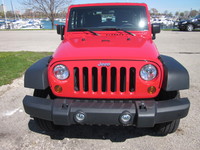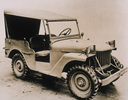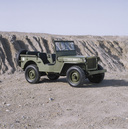2011 Jeep Wrangler, Remember, Ride and Review
 2011 Jeep Wrangler |
Make Me Smarter: Compare 2011 Jeep Wrangler Trims - Jeep Buyers Guide
2011 Jeep Wrangler
An American Icon with a Long Pedigree
By Larry Nutson
Senior Editor, Chicago Bureau
The Auto Channel
The icon of the Jeep brand, the Wrangler remains true to its heritage as the original fun-and-freedom machine. Built on 70 years of legendary heritage, Jeep® is the authentic sport utility vehicle (SUV).
According to a Chrysler history, in July 1940, the U.S. military informed automakers that it was looking for a “light reconnaissance vehicle” to replace the Army's motorcycle and modified Ford Model-T vehicles. The Army invited 135 manufacturers (just think, 135 different companies) to bid on production and developed a lengthy specification list. At first, Willys-Overland and American Bantam Car Manufacturing Company were the only two companies answering the call. Soon, however, Ford Motor Company entered the picture, and competition began among the three over which company would receive the lucrative government contract.
 |
The Army took possession of these vehicles in November 1940 at Camp Holabird, Md. Each of the three designs exceeded the Army's specification of 1,300 lbs., but the Army soon realized that limit was far too low and raised it for the next round of vehicles.
 |
Subsequently, most of the Bantams and Ford GPs produced were sent to Great Britain and Russia as part of the lend-lease program. In Great Britain, the Ford vehicle was popularly known as the “Blitz Buggy.” With modifications and improvements, the Willys Quad became the MA, and later the MB. But the Army, and the world, came to know it as the Jeep®.
Some claimed that the name came from the slurring of the letters “GP,” the military abbreviation for “General Purpose.” Others say the vehicle was named for a popular character named “Eugene the Jeep” in the Popeye cartoon strip. Whatever its origin, the name entered into the American lexicon and, for a while, served almost as a generic title for off-road vehicles, while the Jeep itself became an icon of the war.
Willy trademarked the “Jeep” name after the war (beating Ford to the punch, so it might seem) and planned to turn the vehicle into an off-road utility vehicle for the farm – the civilian Universal Jeep. One of Willys' slogans at the time was “The Sun Never Sets on the Mighty Jeep,” and the company set about making sure the world recognized Willys as the creator of the vehicle.
 |
The 2011 Jeep Wrangler interior highlights include a redesigned instrument panel and new storage areas for improved ergonomics and upgraded materials. A new lockable console and upgraded door armrest areas with comfortable touch points and a redesigned center stack for easier reach and operation. Heated seats and heated power mirrors are now available as well as automatic temperature controls larger rear windows.
 |
 |
The powerplant for all Jeep Wrangler models is a 3.8-liter V-6 engine producing 202 horsepower (151 kW) and 237 lb.-ft. (321 N•m) of torque, backed by a standard six-speed manual gearbox or an available four-speed automatic transmission.
Jeep Wrangler models feature standard ESC, electronic roll mitigation (ERM), all-speed traction control, tire pressure monitoring (TPM), Brake Assist and Hill-start Assist (HSA), which prevents rollback on a graded surface. In addition, available Trailer-sway Control (TSC) monitors vehicle movement relative to the intended path, engaging ESC if the trailer begins to sway outside set parameters.
 |
The Wrangler Sport is priced at $22,045, the Sahara at $27,745 and the Rubicon at $29,820. The 2011 Jeep Wrangler contains 78% U.S./Canadian parts and is built by Chrysler Group LLC in the Toledo Supplier Park in Toledo, Ohio.
One might say: “If it isn’t broke don’t fix it”.
© Larry Nutson


